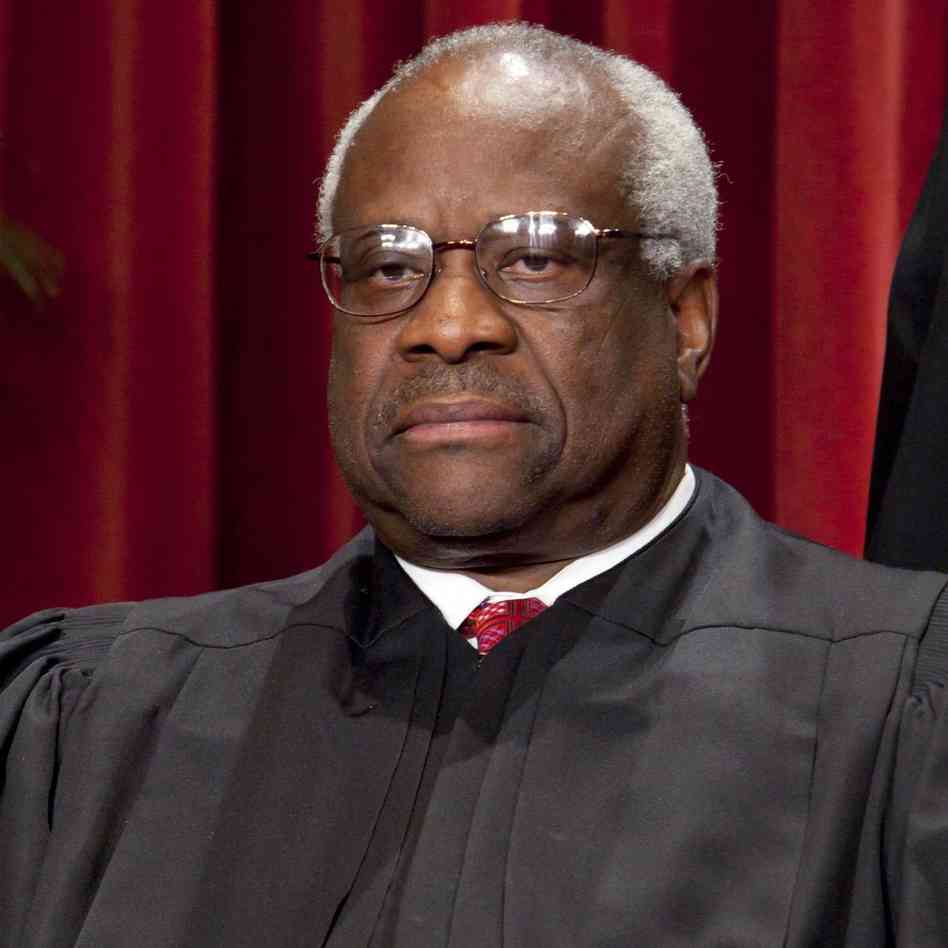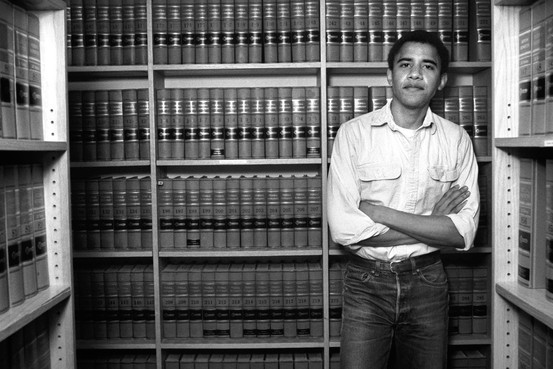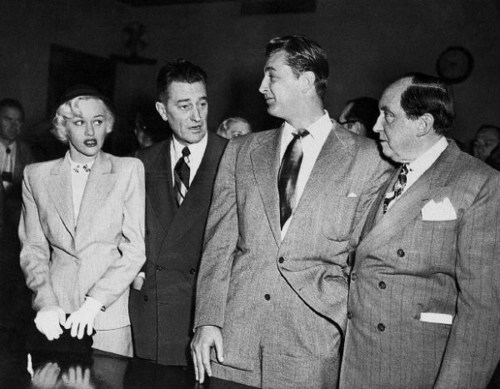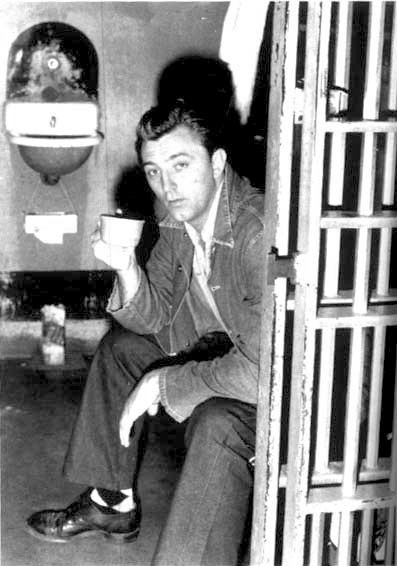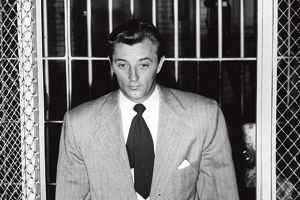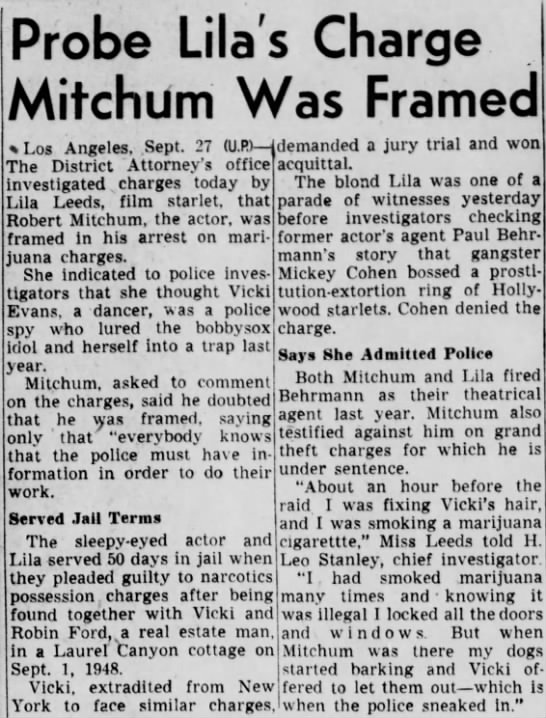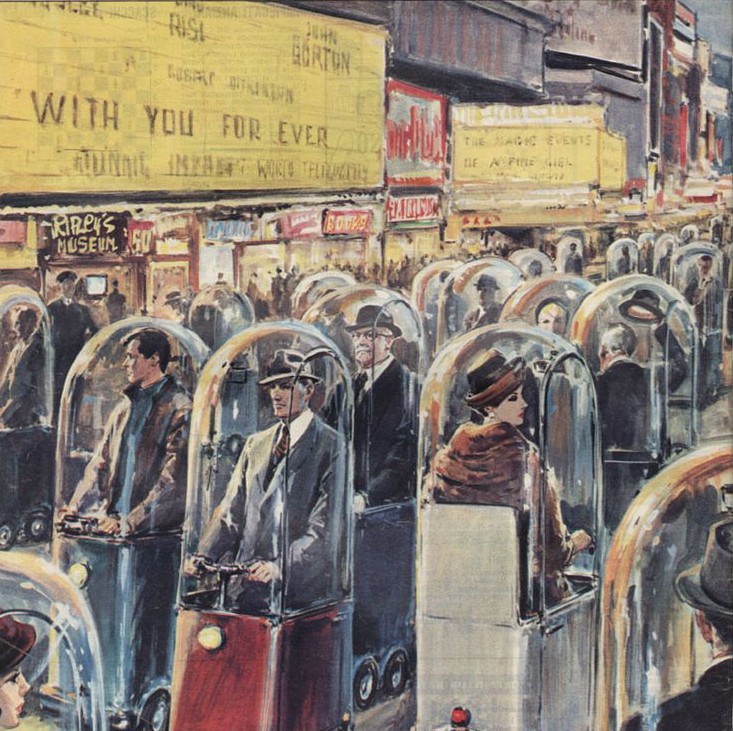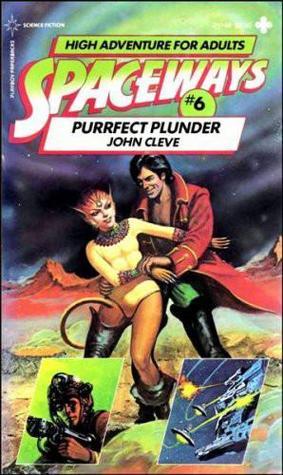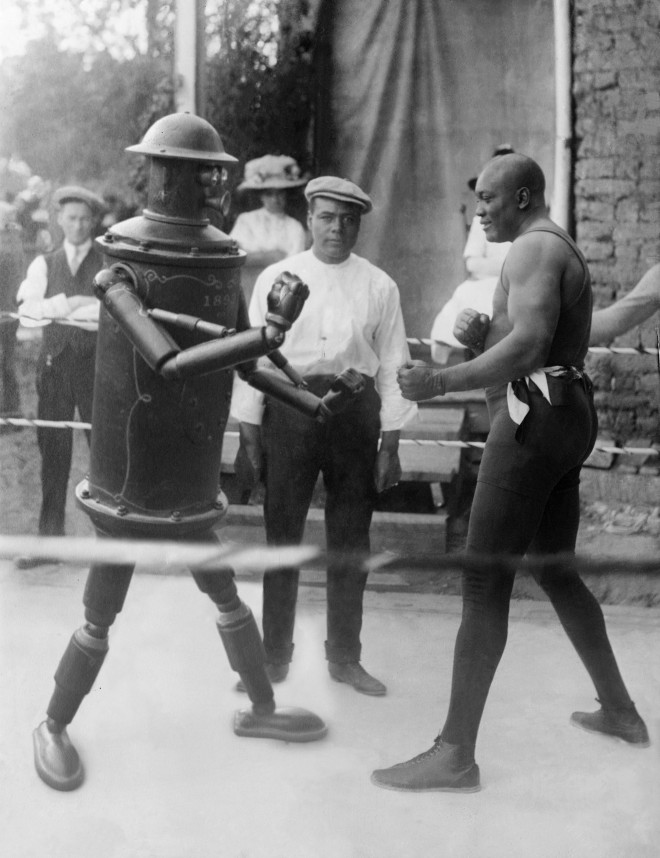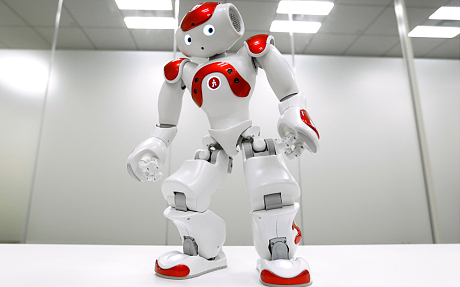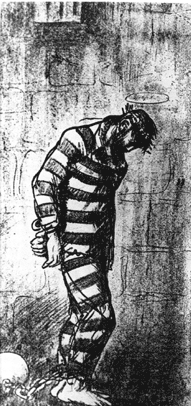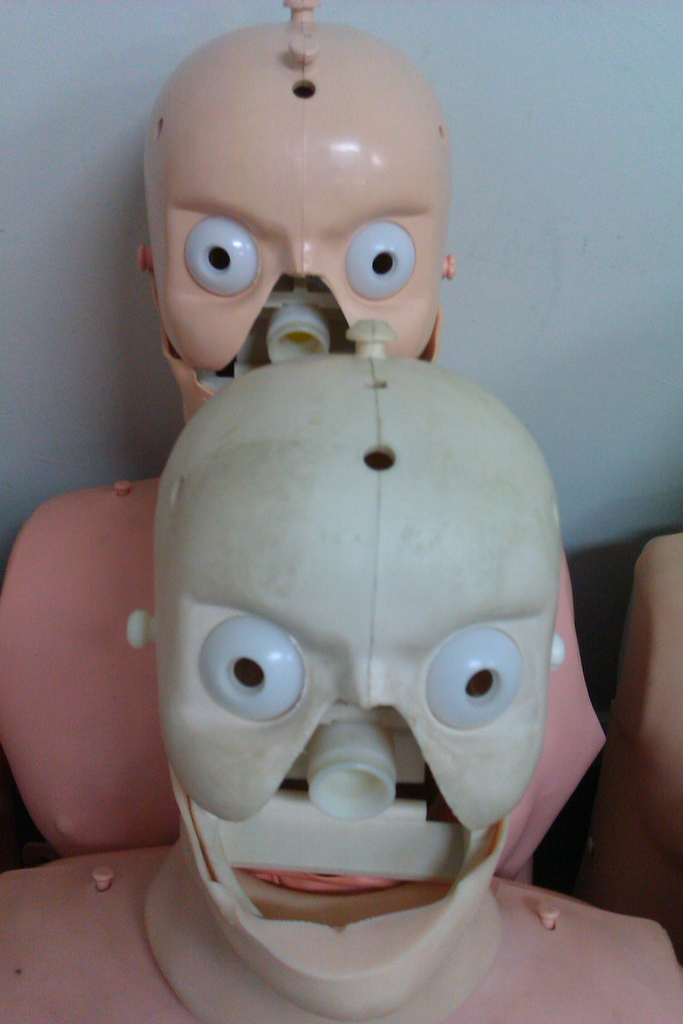Harvard Business School’s Professor Clayton Christensen, student of disruption, being interviewed by VC veteran Mark Suster about the near-term future of higher education, provides the money quote: “In fifteen years from now half of U.S. universities may be in bankruptcy.” America’s higher-education system has been one of our greatest triumphs, one of the great marvels of all civilization, but the growing costs seem unsustainable and the giant money at stake makes nimble reinvention difficult. Some sea change will likely occur.
You are currently browsing the archive for the Urban Studies category.
Tags: Clayton Christensen, Mark Suster
Boston Dynamics, now property of that AI company Google, shows off its latest four-legged robot, Spot. The unguided stair climb is most impressive.
David W. Buchanan, one of IBM’s Watson enablers, agrees with me that Strong AI with human-extincting powers isn’t happening in the foreseeable future, but in arguing against the likelihood of our imminent elimination in a Washington Post editorial, he does concede the growing power of Weak AI, which will continue to introduce automation into more and more workplaces. That could be a great thing or a destabilizing one that encourages even greater income inequality. From Buchanan, a passage about what he terms the “consciousness fallacy”:
Science fiction is partly responsible for these fears. A common trope works as follows: Step 1: Humans create AI to perform some unpleasant or difficult task. Step 2: The AI becomes conscious. Step 3: The AI decides to kill us all. As science fiction, such stories can be great fun. As science fact, the narrative is suspect, especially around Step 2, which assumes that by synthesizing intelligence, we will somehow automatically, or accidentally, create consciousness. I call this the consciousness fallacy. It seems plausible at first, but the evidence doesn’t support it. And if it is false, it means we should look at AI very differently.
Intelligence is the ability to analyze the world and reason about it in a way that enables more effective action. Our scientific understanding of intelligence is relatively advanced. There is still an enormous amount of work to do before we can create comprehensive, human-caliber intelligence. But our understanding is viable in the sense that there are real businesses that make money by creating AI.
Consciousness is a much different story, perhaps because there is less money in it. Consciousness is also a harder problem: While most of us would agree that we know consciousness when we see it, scientists can’t really agree on a rigorous definition, let alone a research program that would uncover its basic mechanisms. The best definitions capture the idea that consciousness grounds our experiences and our awareness. Certainly consciousness is necessary to be “someone,” rather than just “something.” There is some good science on consciousness, and some progress has been made, but there is still a very long way to go.
It is tempting to conflate something that we understand better with something we hardly understand at all, and scientists are not immune to this temptation.•
Tags: David W. Buchanan

A private city of conspicuous consumption being built at Burning Man, that Libertarian wet dream, says so much about the weird welter of technology, wealth inequality and batshit politics that make up much of the mishegas modern American landscape. The opening of Felix Gillette’s Bloomberg story about the 1% decamping to the Nevada desert with AC, Wi-Fi and a wait staff:
For his 50th birthday, Jim Tananbaum, chief executive officer of Foresite Capital, threw himself an extravagant party at Burning Man, the annual sybaritic arts festival and all-hours rave that attracts 60,000-plus to the Black Rock Desert in Nevada over the week before Labor Day. Tananbaum’s bash went so well, he decided to host an even more elaborate one the following year. In 2014 he’d invite up to 120 people to join him at a camp that would make the Burning Man experience feel something like staying at a pop-up W Hotel. To fund his grand venture, he’d charge $16,500 per head.
Tananbaum, a contemporary art collector who resembles the actor Bob Saget, grew up on Manhattan’s Upper East Side and graduated from Yale and Harvard, where he earned both an M.D. and an MBA. After years of starting, selling, and investing in health-care companies, he founded Foresite in 2011. A private venture capital firm with $650 million under management, San Francisco-based Foresite specializes in the health-care and pharmaceutical industries.
Busy building his portfolios, Tananbaum only made it to Burning Man in 2009, the festival’s 24th year, but instantly fell under its spell. While his peers in San Francisco’s high finance circles took up kitesurfing or winemaking, he devoted his spare time to preparations for the next burn. “Jim put a tremendous effort into trying to create something very special for the Burning Man community,” says his friend Matt Nordgren, a former quarterback at the University of Texas, who went on to star in the Bravo reality show Most Eligible Dallas.
For 2014, Tananbaum wanted a camp that was aesthetically novel, ecologically conscious, and exceedingly comfortable.•
Tags: Felix Gillette, Jim Tananbaum, Matt Nordgren
From the October 4, 1938 Brooklyn Daily Eagle:
San Antonio, Texas — Authorities were horrified today by a new development in the “murder farm” case which has been horrifying this community for a week. They had found a witness who said Joe Ball dissected the bodies of his victims and fed them to his pet alligators.•
Tags: Joe Ball
In a Big Think video, Andrew McAfee explains how automation is coming for your collar, white or blue, limo driver and lawyer alike. He leaves off by talking about new industries being created as old ones are being destroyed, but from his writing in The Second Machine Age, the book he co-authored with Eric Brynjolfsson, it’s clear he fears the shortfall between old and new may be significant and society could be in for a bumpy transition.
Tags: Andrew McAfee, Eric Brynjolfsson
Like most aspiring trillionaires, Peter Diamandis would like to live forever. Who can blame him? In a PC Magazine interview conducted by Evan Dayhevsky, the utopian futurist and author of Bold explains why he believes a small number of trillionaires plus a highly automated society won’t equal bloody revolution. An excerpt:
PCMag:
You’ve mentioned in previous media appearances that in the not crazy distant future, we may see the first trillionaires.
Peter Diamandis:
So, we’re at a point now when we’re starting to take on the world’s biggest problems and biggest opportunities. I have two ventures that are big and bold and which I talk about in detail in the book: the first is Planetary Resources. Think about everything that we hold of value here on Earth—metals, minerals, energy, real estate—they are in near infinite quantities in space. You know, some of the asteroids that we [Planetary Resources] are targeting to prospect are trillion-dollar assets. So, that’s one place where we might see the first trillionaires made, and, you know, I’m taking my shot at it.
The second place is in the life sciences. My other company I speak about in Bold is a company I co-founded called Human Longevity, Inc (HLI). Today there are six to seven trillion dollars a year spent on healthcare, half of which goes to people over the age of 65. In addition, people over the age of 65 hold something on the order of $60 trillion in wealth. And the question is what would people pay for an extra 10, 20, 30, 40 years of healthy life. It’s a huge opportunity. These are areas where we may see significant wealth creation.
PCMag:
One of the things you don’t touch on too much in the book are all the people who aren’t entrepreneurs. As things like AI and robotics develop and give businesses the ability produce big ideas, there will be a diminishing need for a human labor force to support it. What does the future hold for all of us non-entrepreneurs and CEOs?
Peter Diamandis:
I think we’re heading towards a world of what I call “technological socialism.” Where technology—not the government or the state—will begin to take care of us. Technology will provide our healthcare for free. The best education in the world—for free. We’ll have access to more and more energy, better quality water, more nutritious food. So, the cost of living and having your fundamentals met will come down.
So I think we’re heading towards a world where people will be able to spend their time doing what they enjoy rather than what they need to be doing. There was a Gallup poll that said something like 70 percent of people in the United States do not enjoy their job—they work to put food on the table and get insurance to survive. So, what happens when technology can do all that work for us and allow us to actually do what we enjoy with our time?•
Tags: Evan Dayhevsky
So many Americans use drugs now, though a good portion of that activity is perfectly legal, prescriptions written and pills placed in orange bottles with white caps. The copay is reasonable. While drugs like Oxycodone are dangerous and open addictions, the legalization of marijuana, a far tamer drug whose prohibition has cost the country financially and in many other ways, still lags behind. A little more than 65 years ago, actors Robert Mitchum and Lila Leeds did jail time for pot possession. Her career was ruined by the scandal and she reportedly started using heroin on the inside, but he bounced back quite nicely. The following article about the case was filed in the September 27, 1949 Brooklyn Daily Eagle.
Tags: Lila Leeds, Robert Mitchum, Robin Ford, Vicki Ford
For Douglas Coupland, the future (that scary thing) and the present have merged. Everyone is a pioneer now, without any movement westward or in any other direction. Everything is within sight, even if most of it is just out of reach. What is the effect on the human mind of permanent tantalization? The opening of his latest Financial Times column:
I’ve spent much of my life waiting for the future to happen, yet it never really felt like we were there. And then, in this past year, it’s become almost instantly and impossible to deny that we are now all, magically and collectively, living in that far-off place we once called the future — and we all know we’re inside it, too. It’s here, and it feels odd. It feels like that magical moment when someone has pulled a practical joke on you but you haven’t quite realised it yet. We keep on waiting for the reveal but the reveal is never going to happen. The reveal is always going to be imminent but it will never quite happen. That’s the future.
What was it that pulled us out of the present and dumped us in this future? Too much change too quickly? One too many friends showing us a cool new app that costs 99 cents and eliminates thousands of jobs in what remains of the industrial heartlands? Maybe it was too much freakish weather that put us in the future. Or maybe it was texting almost entirely replacing speaking on the phone. Or maybe it was Angelina Jolie’s pre-emptive mastectomy. Or maybe it was an adolescent comedy about North Korea almost triggering nuclear war — as well as incidentally revealing Sony’s thinking on Angelina Jolie. Or maybe it was Charlie. How odd that much of what defines the future is the forced realisation that there are many people who don’t want a future and who don’t want the future. They want eternity.
I feel like I’m in the future when I see something cool and the lag time between seeing something cool and reaching for my iPhone camera is down to about two seconds as opposed to 30 seconds a few years back. I feel like I’m in the future whenever I look for images of things online and half the images I see are watermarked and for sale. I feel like I’m in the future when I daydream of bingeing on season three of House of Cards on my new laptop that weighs nothing, never overheats and its battery goes on for ages.
How long is this sensation of futurity going to last? Is it temporary? Maybe society will go through a spontaneous technological lull allowing the insides of our brains to take a time holiday and feel like they’re in 1995, not 2015. But to be practical, that’s probably not going to happen. Ever. Ever.•
Tags: Douglas Coupland
The Andy Warhol quote about everybody in the future being famous for 15 minutes was as prophetic as anything Marshall McLuhan ever said or wrote, but the late Pop Artist’s elevation of the excruciatingly banal has perhaps been equally prescient. In our egalitarian world, talent really isn’t necessary to entertain any longer–just share your minutiae, just live in public. A few spectacles of prowess, like, say, the Super Bowl, still attract attention, but it’s the long tail or ordinariness that wins in the bigger picture. Case in point: In South Korea, that hyper-wired world, “performance eating” has become a phenomenon. It’s food porn, sure, but Stephen Evans of the BBC suspects more is at play. An excerpt:
How do you fancy eating your dinner at home in front of a webcam and letting thousands of people watch? If they like the way you eat, they will pay you money – maybe a few hundred dollars a night… a good salary for doing what you would do anyway. This is happening now in South Korea.
It’s often said that if you want to see the future look at how technology is emerging in perhaps the most connected country on the planet. The food phenomenon is called mukbang – a combination of the Korean word for eating (muk-ja) and broadcasting (bang-song).
I have seen this future in the eighth-floor apartment of Lee Chang-hyun in Seoul (pictured at work, above). At around midnight, he goes online with a couple of friends and performs his meal, spicy raw squid one day, crab the next. “Perform” is the right word. He is extravagant in his gestures, flaunting the food to his computer camera to tantalise the viewers. He eats noisily and that’s part of the show. He’s invested in a good microphone to capture the full crunch and slurp.
This is not a private affair. Some 10,000 people watch him eating per day, he says. They send a constant stream of messages to his computer and he responds verbally (by talking) and orally (by eating, very visibly and noisily).
If the audience like the performance, they allocate him what are called “star balloons” and each of these means a payment to him and to the internet television channel on which he performs. He is coy about how much he earns but the BBC has estimated, by noting the number of star balloons on his screen, that it would run into several hundred dollars for a two-hour stint.
His performance-eating is part of a phenomenon which says something about the way society is changing and about the way television is changing – in Korea today, and perhaps, in your own country, tomorrow.•
________________________________
Andy Warhol eats a burger:
Tags: Stephen Evans

“If blood, human remains, vomit, urine or other bodily fluids affects you negatively, please do not reply.”
Franchise with no Royalties – $12,500 (Downtown)
Isn’t it time that you own your own business? This is your low cost opportunity to do just that. We provide decontamination service to police and correctional facilities. This business opportunity is more than just a Crime Scene Clean-up business. I teach you how to run both businesses: You get the Decontamination business and a Medical Waste Pick-up business.
I will show you how to market your biohazard services to Police Departments, Parks & Recreation, Commercial businesses, Correctional Facilities and more. You can be in business in less then 30 days. Be your own boss by owning your own business. This business opportunity is a distributorship, you own the corporation and are affiliate of the parent company located in Hollywood, Florida.
I will teach you everything there is on operating your own biohazard company. I have been in the business for over 20 years.
Important: If blood, human remains, vomit, urine or other bodily fluids affects you negatively, please do not reply to this add. That is the nature of our business.
The thing about pornographers, those horrible people, is that they were right, their suspicions about us proved true. No matter the moral posture, we did want their wares, and we wanted them to be portable. Before smartphones offering every category you could imagine and some you couldn’t, pulpy paperbacks did the trick. The 1970s were the golden age for such prurient printed matter, until that moment was disrupted by technology, first the VCR and then the Internet. Andrew Offutt (who wrote most often as “John Cleve”) was the lonely and tortured king of the Selectric-produced sex book, making it possible for gentlemen to jerk it to genre art, sordid space odysseys and wankable Westerns. His son Chris, who was deputized with the responsibility of sorting through his late father’s sizable and seemly estate, recalls dad’s uneasy reign in the New York Times Magazine. An excerpt:
The commercial popularity of American erotic novels peaked during the 1970s, coinciding with my father’s most prolific and energetic period. Dad combined porn with all manner of genre fiction. He wrote pirate porn, ghost porn, science-fiction porn, vampire porn, historical porn, time-travel porn, secret-agent porn, thriller porn, zombie porn and Atlantis porn. An unpublished Old West novel opens with sex in a barn, featuring a gunslinger called Quiet Smith, without doubt Dad’s greatest character name. By the end of the decade, Dad claimed to have single-handedly raised the quality of American pornography. He believed future scholars would refer to him as the “king of 20th-century written pornography.” He considered himself the “class operator in the field.”
In the 1980s, John Cleve’s career culminated with a 19-book series for Playboy Press, the magazine’s foray into book publishing. The “Spaceways” series allowed him to blend porn with old-time “space opera,” reminiscent of the 1930s pulps, his favorite kind of science fiction. Dad’s modern twist included aliens who possessed the genitalia of both genders. Galactic crafts welcomed the species as part of their crews, because they were unencumbered with the sexual repression of humans and could service men and women alike. The books were popular, in part, because of their campiness, repeating characters and entwined stories — narrative tropes that later became standard on television. The “Spaceways” series ended in 1985, coinciding with the widespread ownership of VCRs. Men no longer needed “left-handed books” for stimulation when they could watch videotapes in their own homes. The era of written pornography was over.
John Cleve retired. Dad insisted that he himself hadn’t quit, but that John Cleve had. It was more retreat than retirement, a slipping back into the shadows, fading away like an old soldier. Cleve had done his duty — the house was paid off, the kids were grown and the bank held a little savings.
Dad was 52. As Cleve, he published more than 130 books in 18 years. He turned to self-publishing and, using an early pseudonym, Turk Winter, published 260 more titles over the next 25 years.•
Tags: Andrew Offutt, Chris Offutt, John Cleve
The main question I’ve asked since beginning this blog–and one you may be weary of by now–is this: How do we reconcile what’s largely a free-market economy with one that’s highly automated? All work that humans currently do that can be replicated by Weak AI will be ceded to the machines. Will the lack of McJobs (fast-food workers, hotel clerks, customer service, etc.) and many knowledge-based ones (here and here) be replaced by work in other yet-to-be hatched industries? If not, how do the majority of people share in the great bounty that automation will yield? I don’t think getting to own really cheap smartphones will be enough. At some point, the people grow tired of bread and Kardashians. The opening of a Salon article about the destabilizing effects of the Peer Economy by that mensch Robert Reich:
How would you like to live in an economy where robots do everything that can be predictably programmed in advance, and almost all profits go to the robots’ owners?
Meanwhile, human beings do the work that’s unpredictable – odd jobs, on-call projects, fetching and fixing, driving and delivering, tiny tasks needed at any and all hours – and patch together barely enough to live on.
Brace yourself. This is the economy we’re now barreling toward.
They’re Uber drivers, Instacart shoppers, and Airbnb hosts. They include Taskrabbit jobbers, Upcounsel’s on-demand attorneys, and Healthtap’s on-line doctors.
They’re Mechanical Turks.
The euphemism is the “share” economy. A more accurate term would be the “share-the-scraps” economy.
New software technologies are allowing almost any job to be divided up into discrete tasks that can be parceled out to workers when they’re needed, with pay determined by demand for that particular job at that particular moment.
Customers and workers are matched online. Workers are rated on quality and reliability.
The big money goes to the corporations that own the software. The scraps go to the on-demand workers.
Consider Amazon’s “Mechanical Turk.” Amazon calls it “a marketplace for work that requires human intelligence.”
In reality, it’s an Internet job board offering minimal pay for mindlessly-boring bite-sized chores. Computers can’t do them because they require some minimal judgment, so human beings do them for peanuts — say, writing a product description, for $3; or choosing the best of several photographs, for 30 cents; or deciphering handwriting, for 50 cents.
Amazon takes a healthy cut of every transaction.
This is the logical culmination of a process that began thirty years ago when corporations began turning over full-time jobs to temporary workers, independent contractors, free-lancers, and consultants.
It was a way to shift risks and uncertainties onto the workers – work that might entail more hours than planned for, or was more stressful than expected.•
Tags: Robert Reich
From the September 7, 1894 Brooklyn Daily Eagle:
St. Louis, Mo. — Eugene Dickson, a child, swallowed a fly Tuesday afternoon and died yesterday. He was playing in the kitchen and laughing heartily at some incident which had happened when he swallowed the fly. About an hour afterward he became so ill that it was necessary to call a physician. Notwithstanding the efforts of the medical attendant he grew worse very rapidly and died in terrible agony.•
Tags: Eugene Dickson
Before there was turnt, there was turned-on, the term for LSD experimentation taken from the Timothy Leary-Marshall McLuhan co-created mantra “Turn on, Tune in, Drop Out.” Thanks to some fakakta reasoning, Leary was allowed, during his Harvard professor days, to do acid tests on Massachusetts prison inmates, the belief being that the trip would help them arrive at rehabilitation. The subjects were wary of the good doctor, and for good reason, though by Leary’s telling everything went well overall. The guru recalled the experience in an article in the 1969 Psychedelic Review. An excerpt:
I’ll never forget that morning. After about half an hour, I could feel the effect coming up, the loosening of symbolic reality, the feeling of humming pressure and space voyage inside my head, the sharp, brilliant, brutal, intensification of all the senses. Every cell and every sense organ was humming with charged electricity. I felt terrible. What a place to be on a gray morning! In a dingy room, in a grim penitentiary, out of my mind. I looked over at the man next to me, a Polish embezzler from Worcester, Massachusetts. I could see him so clearly. I could see every pore in his face, every blemish, the hairs in his nose, the incredible green-yellow enamel of the decay in his teeth, the wet glistening of his frightened eyes. I could see every hair in his head, as though each was as big as an oak tree. What a confrontation! What am I doing here, out of my mind, with this strange mosaic-celled animal, prisoner, criminal?
I said to him, with a weak grin, How are you doing, John? He said, I feel fine. Then he paused for a minute, and asked, How are you doing, Doc? I was about to say in a reassuring psychological tone that I felt fine, but I couldn’t, so I said, I feel lousy. John drew back his purple pink lips, showed his green-yellow teeth in a sickly grin and said, What’s the matter, Doc? Why you feel lousy? I looked with my two microscopic retina lenses into his eyes. I could see every line, yellow spider webs, red network of veins gleaming out at me. I said, John, I’m afraid of you. His eyes got bigger, then he began to laugh. I could look inside his mouth, swollen red tissues, gums, tongue, throat. Well that’s funny Doc, ’cause I’m afraid of you. We were both smiling at this point, leaning forward. Doc, he said, why are you afraid of me? I said, I’m afraid of you, John, because you’re a criminal. I said, John, why are you afraid of me? He said, I’m afraid of you Doc because you’re a mad scientist. Then our retinas locked and I slid down into the tunnel of his eyes, and I could feel him walking around in my skull and we both began to laugh. And there it was, that dark moment of fear and distrust, which could have changed in a second to become hatred, terror. We’d made the love connection. The flicker in the dark. Suddenly, the sun came out in the room and I felt great and I knew he did too.
We had passed that moment of crisis, but as the minutes slowly ticked on, the grimness of our situation kept coming back in microscopic clarity. There were the four of us turned-on, every sense vibrating, pulsating with messages, two billion years of cellular wisdom, but what could we do trapped within the four walls of a gray hospital room, barred inside a maximum security prison? Then one of the great lessons in my psychedelic training took place. One of the four of us was a Negro from Texas, jazz saxophone player, heroin addict. He looked around with two huge balls of ocular white, shook his head, staggered over to the record player, put on a record. It was a Sonny Rollins record which he’d especially asked us to bring. Then he lay down on the cot and closed his eyes. The rest of us sat by the table while metal air from the yellow saxophone, spinning across copper electric wires, bounced off the wails of the room. There was a long silence. Then we heard Willy moaning softly, and moving restlessly on the couch. I turned and looked at him, and said, Willy, are you all right? There was apprehension in my voice. Everyone in the room swung their heads anxiously to look and listen for the answer. Willy lifted his head, gave a big grin, and said, Man, am I all right? I’m in heaven and I can’t believe it! Here I am in heaven man, and I’m stoned out of my mind, and I’m swinging like I’ve never before and it’s all happening in prison, and you ask me man, am I all right. What a laugh! And then he laughed, and we all laughed, and suddenly we were all high and happy and chuckling at what we had done, bringing music, and love, and beauty, and serenity, and fun, and the seed of life into that grim and dreary prison. …
As I rode along the highway, the tension and the drama of the day suddenly snapped off and I could look back and see what we had done. Nothing, you see, is secret in prison, and the eight of us who had assembled to take drugs together in a prison were under the gaze of every convict in the prison and every guard, and within hours the word would have fanned through the invisible network to every other prison in the state. Grim Walpole penitentiary. Grey, sullen-walled Norfolk.
Did you hear? Some Harvard professors gave a new drug to some guys at Concord. They had a ball. It was great. It’s a grand thing. It’s something new. Hope. Maybe. Hope. Perhaps. Something new. We sure need something new. Hope.•
Tags: Timothy Leary
Japan’s graying, thinning population knows a scarcity of labor, a problem likely to grow worse. A solution: Open up what’s a very homogenous country to immigrants. But Japan’s chosen not to staff up with foreign humans but with foreigners to the species, setting up hologram desk clerks and robot bank tellers. If this AI, the Weak kind but impressive nonetheless, works there, wouldn’t such machines also be employed in places where humans are still readily looking to land a position? From Julian Ryall at the Telegraph:
Standing less than 23 inches tall and with only three digits on hands that are too big for his body, Nao is an unusual appointment at Japan’s biggest bank.
Officials of Mitsubishi UFJ Financial Group Inc believe, however, that this humanoid robot is likely to be an important addition to its operations.
Unveiling Nao in Tokyo on Monday, officials at the bank pointed out that the android is able to speak no fewer than 19 languages and can determine customers’ emotions from their facial expressions.
Nao is still undergoing some minor adjustments, officials said, but the bank anticipates that several of the robots will be meeting and greeting customers in branches from April.
Designed by Aldebaran Robotics SA, a Paris-based subsidiary of SoftBank Corp, Nao gave a demonstration of his skills, greeting a customer with a breezy “Hello and welcome” in fluent English.
“I can tell you about money exchange, ATMs, opening a bank account or overseas remittance,” the android added. “Which one would you like?”
Japanese companies are investing heavily in robots, both as a solution to the nation’s ageing and shrinking population and as a growing business opportunity.•
_____________________________
The future of computerized banking, as envisioned in 1969:
Tags: Julian Ryall
In the U.S., the Right pretends it’s attacking bureaucracy while really angling to subjugate unions and workers; the aim is dismantling safety nets, not improving the situation. But that doesn’t mean mountains of paperwork shouldn’t be a bipartisan scourge. It’s often a maze with no exit. David Graeber’s forthcoming book, The Utopia of Rules, sees something even more sinister than incompetence buried in the files and folders. From Cory Doctorow’s review at Boing Boing:
Bureaucracy is pervasive and metastatic. To watch cop-dramas, you’d think that most of the job of policing was crime-fighting. But it’s not. The police are just “armed bureaucrats.” Most of what police do is administrative enforcement — making sure you follow the rules (threatening to gas you or hit you with a stick if you don’t). Get mugged and chances are, the police will take the report over the phone. Drive down the street without license plates and you’ll be surrounded by armed officers of the law who are prepared to deal you potentially lethal violence to ensure that you’re not diverging from the rules.
This just-below-the-surface violence is the crux of Graeber’s argument. He mocks the academic left who insist that violence is symbolic these days, suggesting that any grad student sitting in a university library reading Foucault and thinking about the symbolic nature of violence should consider the fact that if he’d attempted to enter that same library without a student ID, he’d have been swarmed by armed cops.
Bureaucracy is a utopian project: like all utopians, capitalist bureaucrats (whether in private- or public-sector) believe that humans can be perfected by modifying their behavior according to some ideal, and blame anyone who can’t live up to that ideal for failing to do so. If you can’t hack the paperwork to file your taxes, complete your welfare rules, figure out your 401(k) or register to vote, you’re obviously some kind of fuckup.
Bureaucracy begets bureaucracy. Every effort to do away with bureaucracy ends up with more bureaucracy.•
Tags: Cory Doctorow, Davide Graeber
Of all the tomorrow things that may soon happen, ambulance drones seem like a fairly good bet. They won’t be prohibitively expensive and can deliver first responders into the middle of traffic accidents and other messy entanglements. From Mark Wilson at Fast Company:
In emergencies, seconds count. An estimated 1,000 “saveable” lives are lost a year because of slow emergency response in the nation’s biggest cities. But in traffic-jammed urban environments, how can a four-wheeled ambulance be expected to make it anywhere and back quickly?
Design firm argodesign has a wild conceptual solution. It’s a one-person ambulance drone modeled after a standard quadcopter—driven by a GPS, pilot, or combination of both—that could be dispatched to an emergency scene with a single EMT. It’s designed to land almost anywhere, thanks to a footprint the size of a compact car. The EMT stabilizes the patient, loads him up, and sends him back to the hospital for further treatment.
“Obviously, it’s not a thoroughly vetted concept, but I think it’s extremely intriguing where drones might show up,” says Mark Rolston, founder of argodesign. “It would be nice to see them used this way, rather than another military function or more photography.”
The idea was born from a team brainstorming session around how health care could become more accessible. The designers first thought about how they could build a better ambulance, and the rise ofautonomous vehicles inspired them to consider a self-driving ambulance. Then they thought of helicopters and drones, and the rest developed from there.•
Tags: Mark Rolston, Mark Wilson
William Butler Yeats famously pined for his muse, Maud Gonne, who rejected him. When her daughter, Iseult, turned 22, the now-midlife poet tried for her hand and was likewise turned away. While apparently no one in the family would fuck Yeats, Maud did apparently have sex in the grave of her infant son who had died at two, believing some mystical hooey which said the soul of the deceased boy would transmigrate into the new baby if she conceived next to his coffin. Well, okay. From Hugh Schofield at the BBC:
Actress, activist, feminist, mystic, Maud Gonne was also the muse and inspiration for the poet W B Yeats, who immortalised her in some of his most famous verses.
After the Free State was established in 1922, Maud Gonne remained a vocal figure in Irish politics and civil rights. Born in 1866, she died in Dublin in 1953.
But for many years in her youth and early adulthood, Maud Gonne lived in France.
Of this part of her life, much less is known. There is one long-secret and bizarre episode, however, that has now been established as almost certainly true.
This was the attempt in late 1893 to reincarnate her two-year-old son, through an act of sexual intercourse next to the dead infant’s coffin. …
Having inherited a large sum of money on the death of her father, she paid for a memorial chapel – the biggest in the cemetery. In a crypt beneath, the child’s coffin was laid.
In late 1893 Gonne re-contacted Lucien Millevoye, from whom she had separated after Georges’ death.
She asked him to meet her in Samois-sur-Seine. First the couple entered the small chapel, then opened the metal doors leading down to the crypt.
They descended the small metal ladder – just five or six steps. And then – next to the dead baby’s coffin – they had sexual intercourse.•
Tags: Hugh Schofield, Lucien Millevoye, Maud Gonne
From the September 7, 1944 Brooklyn Daily Eagle:
Birmingham, Ala. — Arnold Earnest, 24, who lived for three years in a cave to avoid the draft, began serving a five-year Federal Prison sentence today.
The farm boy was minus his bushy mustache, long hair and carefree manner as he was led from the courtroom where he was sentenced. He said it was “powerful hard” to sleep in jail.
Earnest lived in the woods of Fayette County, Ala., during the years he was a fugitive, eating berries and trapped animals. His shelter was a cave.
When arrested by Federal agents, he had not heard of Pearl Harbor.•
Tags: Arnold Earnest
There was a time not too long ago, before the words selfie and Kardashian were household, when Neil Hamburger, the alter-ego stand-up persona of Gregg Turkington, was even sadder than the rest of America, though we seem to have caught up. Through excruciatingly terrible jokes, he coldly points out that much of our pop culture exists merely because of how depressed and horny we are, vomiting forth the unbearable heaviness of our being. When the audience turns on his flailing, coughing, anti-comedy Pupkin-ness, Hamburger tries to manipulate mercy from them, claiming to have cancer. He isn’t feeling well, and how exactly are you and I and our chaturbating buddies?
Hamburger’s horribleness has hatched a movie which is currently at Sundance. From Matt Patches at Grantland:
In hell’s dingy comedy club, Neil Hamburger takes the stage each night, forcing audiences to confront the life they once lived. Still there are laughs — after all, this is a crowd that wound up in hell. A sample of his devilish comedy:
What’s the difference between Courtney Love and the American flag?
It would be wrong to urinate on the American flag.
For the living willing to challenge themselves, comedian Gregg Turkington tours the country as his tuxedoed alter ego Hamburger, delivering one-liners with nasally sadness. Audiences shell out to see Hamburger nose-dive with sets that would make Rupert Pupkin bite his lip. Though Turkington’s found success in his own shoes, acting in film and television, writing, and working with musicians, his weaponized jokester is the star.1 Neil Hamburger commands attention and remains an ever-changing creature, 20 years spent warping American pop culture with a fun-house mirror.
In the age of adaptation, any recognizable face is a movie waiting to happen. Borat got a movie. MacGruber got a movie. The Lego “minifig” got a movie. Fred Figglehorn got three nightmare-fuel movies (ask your kids). Saturday Night Live was in the character exploitation business before it was cool, churning out movies like It’s Pat, Coneheads, Stuart Saves His Family, and Wayne’s World. Despite a shtick that sends sensitive souls directly to therapy, Neil Hamburger’s day in the cinematic sun was inevitable. And now it’s here: Entertainment, a 2015 Sundance Film Festival premiere that extrapolates Turkington’s ongoing work into a bleak vessel of human failure. That Neil Hamburger show from hell? We’re already living it.•
Peyote has historically been central to the Native American church meeting. In a 1967 Psychedelic Review article, Stewart Brand, Prankster and prophet, wrote of one such congregation he attended. An excerpt:
“The meeting is mandala-form, a circle with a doorway to the east. The roadman will sit opposite the door, the moon-crescent altar in front of him. To his left sits the cedarman, to his right the drummer. On the right side as you enter will be the fireman. The people sit around the circle. In the middle is the fire.
A while after dark they go in. This may be formal, filling in clockwise around the circle in order. The roadman may pray outside beforehand, asking that the place and the people and the occasion be blessed.
Beginning a meeting is as conscious and routine as a space launch countdown. At this time the fireman is busy starting the fire and seeing that things and people are in their places. The cedarman drops a little powder of cedar needles and little balls, goes down the quickest. In all cases, the white fluff should be removed. There is usually a pot of peyote tea, kept near the fire, which is passed occasionally during the night. Each person takes as much medicine as he wants and can ask for more at any time. Four buttons is a common start. Women usually take less than the men. Children have only a little, unless they are sick.
Everything is happening briskly at this point. People swallow and pass the peyote with minimum fuss. The drummer and roadman go right into the starting song. The roadman, kneeling on one or both knees, begins it with the rattle in his right hand. The drummer picks up the quick beat, and the roadman gently begins the song. His left hand holds the staff, a feather fan, and some sage. He sings four times, ending each section with a steady quick rattle as a signal for the drummer to pause or re-wet the drumhead before resuming the beat. Using his thumb on the drumhead, the drummer adjusts the beat of his song. When the roadman finishes he passes the staff, gourd, fan and sage to the cedarman, who sings four times with the random drumming. So it goes, the drum following the staff to the left around the circle, so each man sings and drums many times during the night.•
As a follow-up to the post which quoted former Google and current Baidu AI research scientist Andrew Ng, here’s a fuller explanation of his thoughts about the existential threat of intelligent machines, from a Backchannel interview by Caleb Garling:
Caleb Garling:
Do you see AI as a potential threat?
Andrew Ng:
I’m optimistic about the potential of AI to make lives better for hundreds of millions of people. I wouldn’t work on it if I didn’t fundamentally believe that to be true. Imagine if we can just talk to our computers and have it understand “please schedule a meeting with Bob for next week.” Or if each child could have a personalized tutor. Or if self-driving cars could save all of us hours of driving.
I think the fears about “evil killer robots” are overblown. There’s a big difference between intelligence and sentience. Our software is becoming more intelligent, but that does not imply it is about to become sentient.
The biggest problem that technology has posed for centuries is the challenge to labor. For example, there are 3.5 million truck drivers in the US, whose jobs may be affected if we ever manage to develop self-driving cars. I think we need government and business leaders to have a serious conversation about that, and think the hype about “evil killer robots” is an unnecessary distraction.•
Tags: Andrew Ng, Caleb Garling





